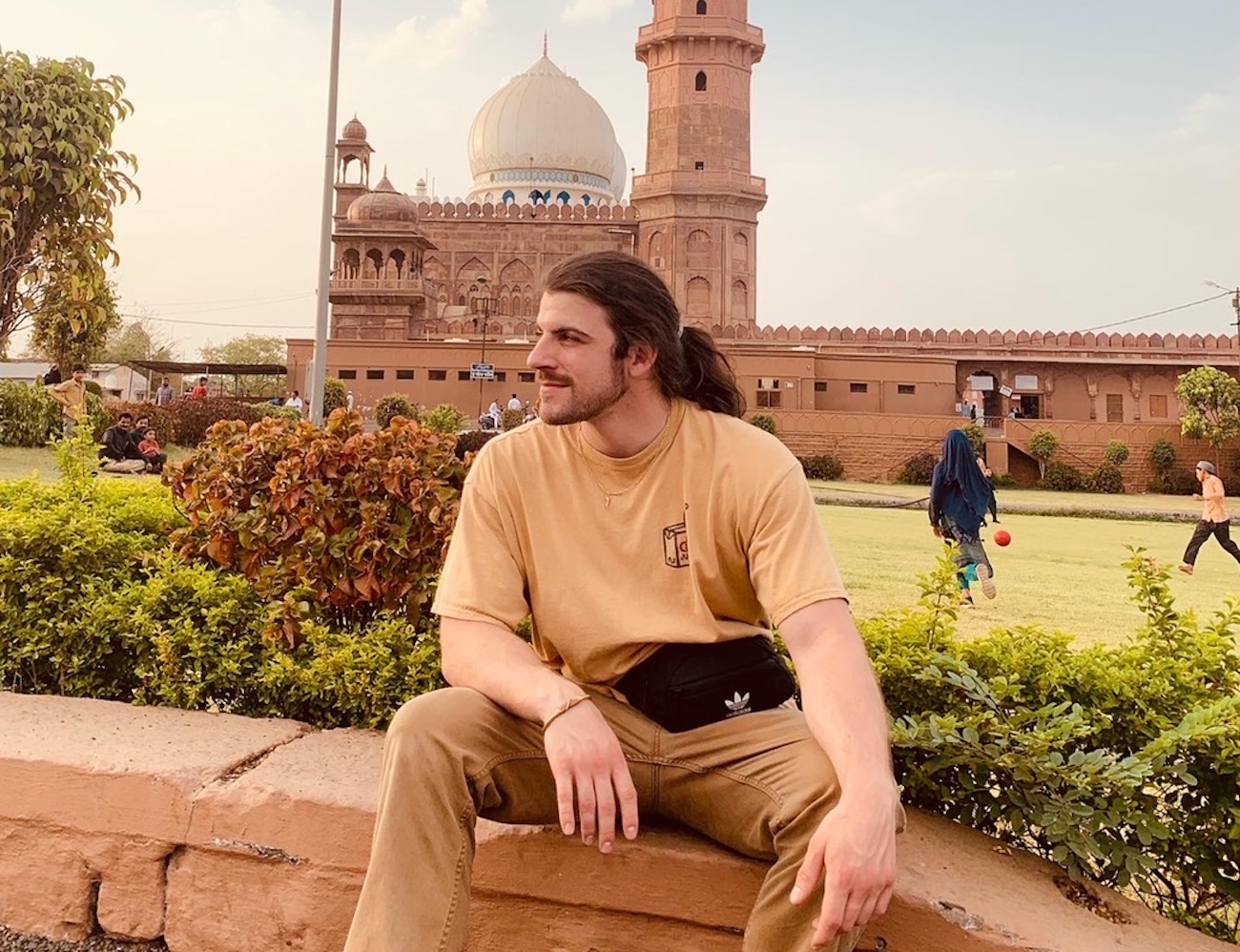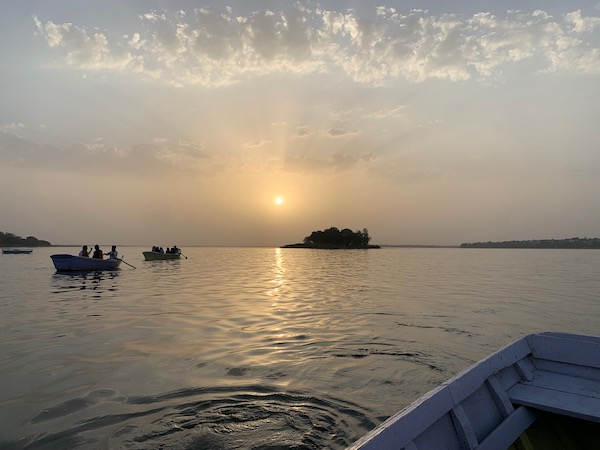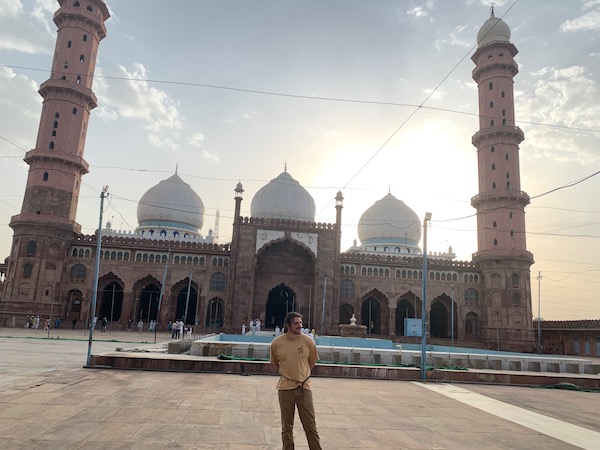- In 2022, I got to experience firsthand the state of Muslim life in India when I was a guest at a wedding in Bhopal. Here’s how it went.

“You’ll have converted me to Islam by the end of this trip,” I quipped to Hamza from across the wooden rowboat. We were on our way to a little island in Bhopal’s Upper Lake to visit a dargah, the name for Sufi Muslim shrines. This dargah was for the Sufi saint named Shah Ali Shah.
“No, no, you have it all wrong,” Hamza corrected me through laughter. The man we paid 300 rupees to ferry us to the island didn’t speak English and paid no attention. “I am not converting you, I am reverting you. You were born a Muslim in the eyes of Allah but then strayed from the faith when you became an atheist. I’m just guiding you back to the one true path.” This became our running joke as he chaperoned me through India: Hamza was reverting me, civilizing the savage, and bearing the Brown Man’s Burden with enough humor and pride to make Kipling roll in his grave like a birling log.

Ali Shah’s island is small and circular. The surrounding edge is marsh and most of its solid center, including the shrine, is hidden from the lake by a perimeter of thin trees. As we disembarked at the narrow dock we realized I might not be allowed in. I was wearing shorts, and men must cover their legs in Muslim holy spaces. It was a stupid mistake, but we were in central India during a historically violent heat wave, and I foolishly decided to dress like it. Hamza had me wait on the dock and went ahead to inveigle the Imam.
As Hamza’s guest, visiting to learn about South Asian Muslim culture, I was welcomed into every mosque before this. Colorism on the subcontinent also means lighter-skinned people, especially white foreigners, are treated with unearned preference. We planned for this and uncomfortably used it to our advantage when navigating conflict, but it mostly just made people eager to talk with me. White faces are already uncommon in Bhopal, especially in Muslim spaces. There I simply met the curious stares with a smiling “Asalaam alaykum,” alighting their faces with happy surprise that I knew their greeting.
My experience of Muslim hospitality culture outdid my expectations. The reception by Hamza’s relatives was utterly novel. Around the Old City, we were also welcomed into the back of market stalls for chai and dropped in on a wedding at the Taj-ul Masjid that we weren’t invited to. Hamza, tirelessly talking himself into everybody’s good graces, was personally invited to at least three weddings. Against this background, we hoped the Imam of Ali Shah’s shrine wouldn’t be an exception. And if anyone was going to talk our way in, it was Hamza.
I looked up when Hamza called my name. The Imam, dressed in white from his skull cap to his beard and kurta, was beside him eagerly waving me forward. He said he was very excited to have us there. And my shorts? No problem at all. In fact, he beseeched us to take as much time as we wanted inside the shrine. No rush. If we needed anything we only had to ask. I didn’t know what Hamza told the imam, but I was now convinced he could sell steak to a steer.
Hamza could pass as an upper-caste Hindu if he didn’t reveal his name. He used this ability once before, on a train, to intervene when a group of young Hindu men was berating an elderly Muslim woman.
The shrine was extravagantly modest: a square, single-roomed building covered in colored tiles and shaded by an overhanging; wrap-around roof supported by a pillar in each corner. The entire structure is crowned with a green and white Mughal dome and inside is the tomb of Shah Ali Shah. Standing together beside the tomb Hamza told me he’d pray in silence, and I could meditate on whatever felt appropriate.
White atheists from rural Pennsylvania aren’t usually the target demographic for Muslim shrines in central India, and yet there I was. That seems appropriate, I thought, and recalled that first step on my long and somewhat accidental journey to the Indian subcontinent.
In 2017 I made a Kashmiri-Pakistani pen pal named Afaf who introduced me to the obsidian-tipped writing of Arundhati Roy. Though I didn’t know it at the time, that was the start of a years-long study of the rise of Hindu nationalism, a movement inspired by European Fascism. So, when I met a handful of Indians – Hamza among them – at an international collegiate conference in 2019, the friendship grew around our common alarm. Then in 2022, the opportunity came for me to experience firsthand the state of Muslim life in India. I was invited as a guest to the wedding of Hamza’s cousin in Bhopal, a sweltering textbook of a city in Madhya Pradesh that was the seat of its eponymous Muslim princely state before Partition.
Our first instance of casual hostility with Hindus happened while checking into our hotel in Bhopal. The expressions of the men at the front desk turned sour when they asked for Hamza’s full name and were given a Muslim one. But he was with me, and they wouldn’t risk giving a rare American guest a bad experience, particularly on his first time in their country. Hamza made sure to remind them of this whenever it was necessary.
Hamza could pass as an upper-caste Hindu if he didn’t reveal his name. He used this ability once before, on a train, to intervene when a group of young Hindu men was berating an elderly Muslim woman. He did something vaguely similar in Bhopal but conscripted me along with him.

Inside a kurta shop, we noticed pictures the shopkeeper hung behind the register, photos of the Lord Ram and Prime Minister Narendra Modi. Modi is the head of India’s ruling party, the Hindu supremacist Bharatiya Janata Party (BJP), which is working diligently to collapse India into a nation-state of and for Hindus. He was also the chief minister of Hamza’s home state of Gujarat in 2002. As chief minister that year Modi oversaw a pogrom in which over 1,000 Muslims were tortured and murdered in the streets with the help of police. Because of the pogroms, Modi’s domestic popularity grew, and the U.S. government banned him from traveling to America. The ban was lifted, however, when he was elected Prime minister in 2014. Ram is an avatar of another God, Vishnu, and has become the patron God for Hindu nationalists who, when lynching Muslims, force them to chant “Jai Shri Ram.” This means “victory to Lord Rama,” or “hail Lord Ram.”
I was trying on a blue kurta in the back of the shop when Hamza told me he’d secured a discount. “I told him you are a devotee of Lord Ram,” he said, “and that we just came from the Ram temple, the one we saw a block away.” The man was so pleased to hear this that he cut our price in half. But we had to sell it. “Remember to shake his hand and say, ‘Jai Shri Ram’ when we leave,” Hamza said. He would too.
In truth, Hindutva shopkeepers were among our lesser concerns. After Bhopal, we’d travel to Kashmir, a Muslim region held by India under the world’s densest military concentration. A land where freedom – Azadi – is an aspiration, not a reality. We would only go there together; he provided cultural access while my whiteness and American passport could lubricate interactions with the armed forces. Standing next to Ali Shah’s tomb I considered our good fortune up to that point and prayed he bless us with more as my personal Saint of Safe Travel. I don’t believe in God, but I needed all the help I could get. We wanted no trouble in Kashmir.
We had taken our time in the shrine. Our ferryman stood on the dock frowning in agitation. We thanked the Imam for his hospitality, he gave us a blessing, and we said Allah Hafiz before walking back to the dinghy. With some distance between us and the Island, the setting sun, and the curved silhouettes of birds and bats framing it like a photograph, Hamza asked me a question.
“Hey, do you know why the Imam was so eager for you to come up? Do you know what I told him?” I suspected that the answer was not ‘the truth,’ and prepared for a punchline. “I told him you are a new convert, at the beginning of your journey to Islam!” We both laughed a little too loudly. I’ve never been conscripted into two religions in the same week. Then he leaned forward and in a voice like a pat on the knee he said to me, “Welcome back to the one true path.”
Brandon Langston is an American historian based in Pennsylvania whose research focuses on racism, social hierarchy, and inter-group conflict. He is also a writer of mostly non-fiction essays on a wide range of subjects.
